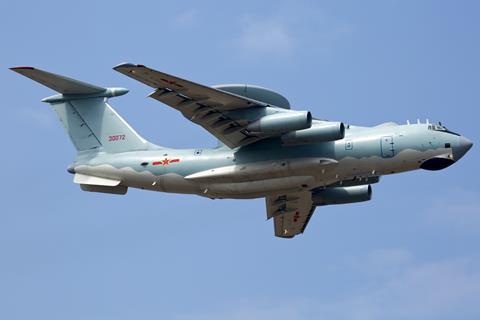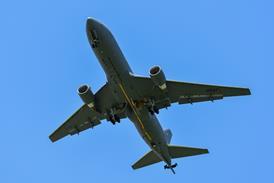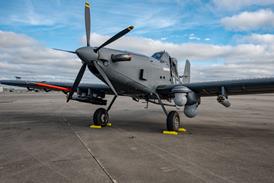Beijing is taking steps to advance its airborne early warning and control (AEW&C) capabilities, with the emergence of the long-rumoured Xian KJ-3000.
Images have appeared on Chinese social media showing a large, four-engined AEW&C aircraft derived from China’s homegrown strategic transport, the Y-20.

The aircraft appears to be powered by four indigenous Shenyang WS-20 high-bypass turbofans. The new engine – which also powers new examples of the Y-20B transport – should be more efficient than the Y-20’s legacy powerplant, the Soloviev D-30KP-2.
The thick line across the underside of the aircraft’s overhead-mounted radome suggests that it contains two active electronically scanned array (AESA) radars, and likely needs to rotate to ensure full coverage.
There is speculation that the aircraft’s fuselage boasts side-mounted AESA radars. These are a feature of another advanced Chinese AEW&C aircraft, the KJ-700, a derivative of the Shaanxi Y-9 tactical transport that has entered People’s Liberation Army Air Force (PLAAF) service in small numbers.
When it enters service the KJ-3000 will become the PLAAF’s second jet-powered AEW&C aircraft after the KJ-2000, a derivative of the Ilyushin Il-76.
While the KJ-2000 is understood to be the PLAAF’s most capable AEW&C type, with a non-rotating, three-sided AESA array, there are only four operational examples.
Indeed, the KJ-3000 has long been seen as the eventual replacement for the PLAAF’s small KJ-2000 fleet.
With its efficient engines the KJ-3000 is likely to have a clear endurance advantage over the KJ-2000. Moreover, the limited available imagery makes it clear that the type has an air-to-air refuelling probe, something lacking in the KJ-2000.
It is also probable that the WS-20 engine has superior electrical generation capabilities compared with its Russian made predecessor. This is a key consideration given the power of the KJ-3000’s sensors and the high degree of energy-intensive computing required for an advanced AEW&C capability. In a conflict, the KJ-3000 will be called on detect difficult targets such as stealth aircraft and a dizzying array of unmanned systems and decoys, as it also directs a broad spectrum of joint Chinese capabilities.
While China’s KJ-200 and KJ-500 platforms are understood to be very capable, they are turboprops with limited operating ceilings. A large jet such as the KJ-3000 will be able to operate at greater altitudes, giving its radar arrays greater coverage, and allowing it to operate further away from adversary fighters.

The ability to operate further back could help counter advances in adversary air-to-air capabilities. The US Navy’s Raytheon AIM-174B air-to-air missile, a derivative of the ship-launched SM-6, has been deployed with the Boeing F/A-18E/F Super Hornet. Should a conflict occur, a clear target set for this weapon will be Chinese intelligence, surveillance and reconnaissance assets, including slow-moving AEW&C aircraft.
In its recent assessment of Chinese military power, the US Department of Defense did not mention the KJ-3000 or the KJ-700. It did state, however, that the KJ-500 continues to join the PLAAF.
“These aircraft amplify the PLAAF’s ability to detect, track, and target threats in varying conditions, in large volumes, and at greater distances,” says the report.
“It extends the range of the PLA’s [integrated air defence] network. Furthermore, [the People’s Republic of China] has produced at least one KJ-500 with an aerial refuelling probe, which will improve the aircraft’s ability to provide persistent AEW&C coverage.”
The air-to-air refuelling capability of the KJ-3000, which is likely to be far more capable AEW&C platform than the KJ-500, will certainly get the Pentagon’s attention.
The KJ-3000 builds on remarks made in July 2021 by Lu Jun, chief designer of the KJ-500. He envisaged an AEW&C network made up of traditional platforms and smaller aircraft, with the assets working together to build an “information network”.
In his view the smaller AEW&C aircraft are more capable of dealing with targets such as stealth aircraft and UAVs.
As with all Chinese defence programmes the development status of the KJ-3000 is not clear – apart from the fact that it is in flight testing. Given China’s rapid advances with the Y-20 platform and WS-20, not to mention its growing prowess with AESA radars, the KJ-3000’s arrival in PLAAF service can be expected within the coming years, with imagery on Chinese social media marking its progress.


























